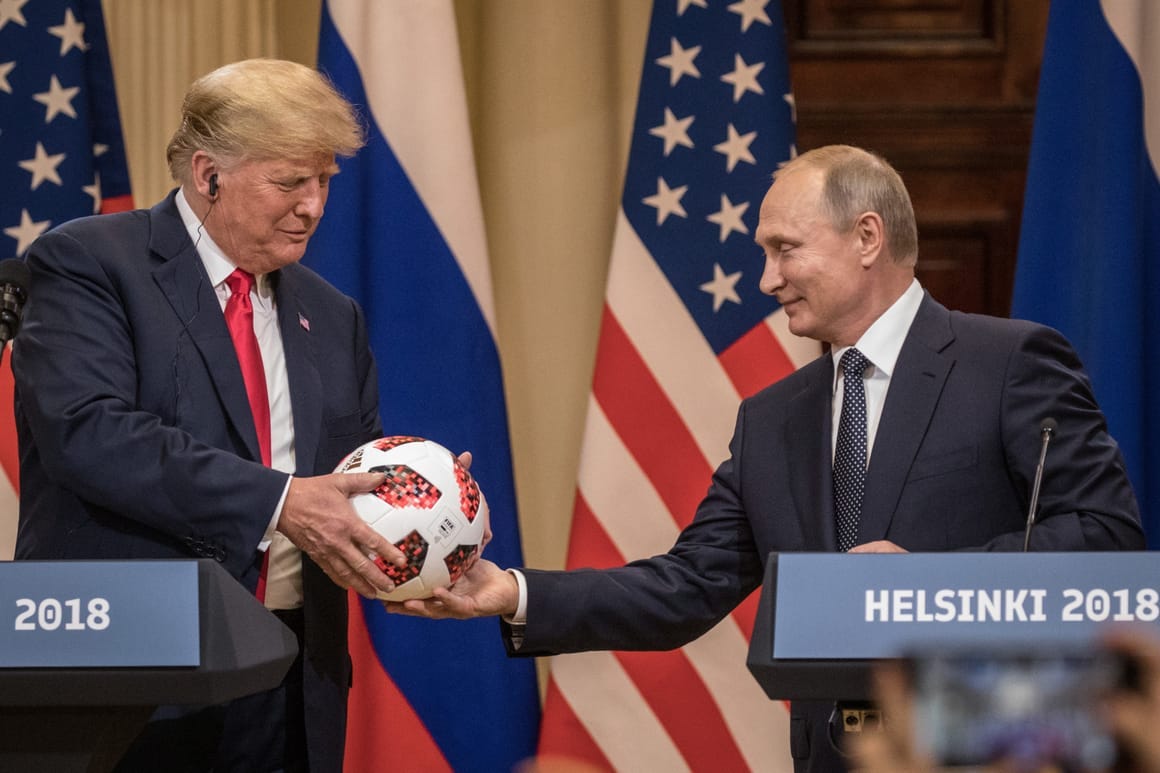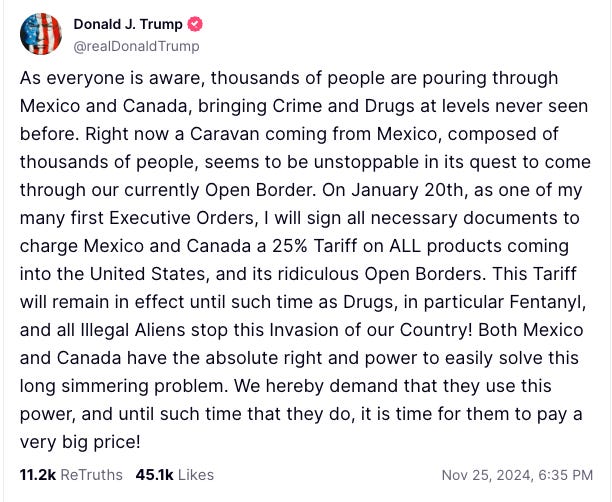Trump's Madman Foreign Policy
A Pale Imitation of Richard Nixon
Donald Trump’s foreign policy operates on two tracks. One is his personal foreign policy, where Trump makes pronouncements by tweet without consultation and forces a response. The other is the traditional track, where the bureaucracy of State and Defense operate through their normal procedures and policy processes.
Trump has singular control of the former, which, while loud, is often not effective in producing substantive policy change. The other track is more effective and operates largely independently under the guidance of Trump’s cabinet picks.
Personal Madman Diplomacy
In his first term, Trump made a habit of announcing foreign policy changes by tweet without consultation with the affected countries. He made threats to countries like Iran and North Korea. He announced tariffs on a whim as a form of negotiating leverage.
It was the “madman theory” on steroids. The idea is that the apparent irrationality and volatility of the president’s behavior could extract concessions from world leaders to avoid provocations that could have unpredictable results.
This approach originated with Richard Nixon, who extracted concessions from the Soviet Union in October 1969 by putting the military on high-alert and ran bombers armed with nuclear weapons near the Soviet border. He used the approach to force North Vietnam to the negotiating table in the same year.
The difference in Trump’s approach is his threats by tweet are standard operating procedure. Madman theory works on the assumption that the president is experiencing an emotional, volatile reaction, and is not just blustering as a negotiation tactic. In fact, the acknowledgment that it is only a negotiating tactic undermines its effectiveness.
The approach other countries take towards Trump under these circumstances is, rather than give substantive concessions, they provide something Trump can claim as a “win”. He has shown that if he gets his win, the threat just disappears into the ether. That is mostly benign with countries who are allies, but problematic with Russia or China.
A case-in-point is his threat to impose 25% tariffs on Canada and Mexico, announced through Truth Social. 25% tariffs would increase the costs of gas and many other things you buy at the grocery store overnight. The threat only provides leverage IF Trump is willing to impose these types of price increases on the American people.
His supporters are making the argument that this is no big deal because he won’t actually impose the tariffs and it’s just a negotiating tactic. But if that’s true, then they have no value as a negotiating tactic, and this means Trump has spooked the markets, created uncertainty for investors, and undermined the trust of allies for nothing substantive.
In a victory of style over substance, Donald Trump gets to look like he’s standing up to those allegedly screwing over America while using the American people as leverage and undermining our standing in the world. In return, we will get a strongly worded statement from Mexico and Canada signaling support for securing the border and stopping illegal migrants.
From the perspective of America’s interests, this approach produces, at best, some small, short-term benefits. In the long term, it undermines the leverage of the U.S. in negotiations and the strength of our commitments. Canada is a NATO ally, and Mexico, Canada, and the U.S. all signed the USMCA trade agreement that Trump negotiated in his first term. Arbitrary tariffs would undermine these commitments.
The Official Trump Policy
Discerning the official Trump administration foreign policy is much easier than predicting the temporary whims of the president. Without strong personalities like James Mattis and Rex Tillerson in his cabinet, the foreign policy of the second Trump term will likely be built around populist themes like trade and immigration and an “America First” ethos.
China: Continuity is probable, as Biden largely continued Trump’s tariffs and hardline policies but focused them on key industries with national security implications. The Trump administration will likely broaden the emphasis to Chinese trade in general and reducing the trade deficit. The Trump administration will be packed with China hawks, including incoming Secretary of State Marco Rubio.
Trump advocates for reducing U.S. dependence on China, particularly in critical sectors like electronics, steel, and pharmaceuticals. He initiated a trade war during his presidency, imposing tariffs averaging 18% on hundreds of billions of dollars worth of Chinese goods, and has suggested potentially tripling these tariffs if reelected. His recent Truth Social announcement proposed a blanket 35% tariff.Middle East: Trump’s approach will be to draw a harder line on Iran and allow Israel to operate largely with impunity to achieve its security objectives. Pressure will continue on Iran while the Arab states, particularly Saudi Arabia, will be pressured to normalize ties with Israel. This approach might bring peace to the region but will come at the expense of the Palestinian’s aspirations for statehood.
Europe: European leaders are understandably nervous about President-elect Trump’s plans for NATO, as he’s indicated America may renege on its security commitments. New NATO chief Mark Rutte, the former prime minister of the Netherlands, was selected partly because he was one of the few European leaders who developed a positive working relationship with Trump. There is an understanding that they will have to work with him.
The ongoing invasion of Ukraine by Russia is the most immediate issue. Trump has signaled he will use the withdrawal of American support as leverage to bring Ukraine to the negotiating table. Europe has signaled it will independently continue to support Ukraine, so there is a potential for the United States to lose its leverage and ability to prevent a broader regional war.Trade: Centers on economic nationalism, aiming to reduce U.S. trade deficits, revive manufacturing, and curb offshoring. He proposes universal tariffs on imports, retaliation against countries with higher tariffs on U.S. goods, and penalties for nations avoiding the U.S. dollar. The more protectionist approach from Trump’s first term will persist, as will his skepticism of the international trade regime and associated institutions, like the WTO.
Immigration: A hardline stance on immigration and border security, reducing both legal and illegal immigration. Central to his plan is the promise of the "largest domestic deportation operation in American history”. He wants to enlist the military in deportations and reimpose strict asylum policies, including his "Remain in Mexico" program and the use of Title 42 to expel migrants on public health grounds. Trump also seeks to end birthright citizenship for children born to illegal immigrants and reimpose his travel ban on countries with terrorist links. He plans to suspend refugee resettlements, reduce temporary protected status (TPS) for certain nations, and limit visa programs while pushing for a merit-based immigration system.
Diplomacy: Trump’s foreign policy emphasizes national sovereignty and skepticism toward multilateral agreements. On global health, Trump is skeptical of international health efforts and would possibly withdraw from the WHO. Trump remains a staunch critic of international climate agreements. He plans to withdraw from the Paris Agreement again and will likely keep the United States out of climate negotiations. Expect an aggressive America First approach that seeks to maximize short-term gains at the expense of long-term relationships.
Donald Trump’s foreign policy blends personal unpredictability with a more structured approach driven by populist ideals, focusing on national sovereignty, economic nationalism, and skepticism toward multilateralism. His "madman diplomacy" style, characterized by threats and sudden policy shifts, creates uncertainty and undermines U.S. credibility, especially with allies. While this approach may yield short-term gains, such as small diplomatic concessions or trade wins, it risks weakening long-term partnerships and international trust.
Trump's official foreign policy, shaped by his "America First" ethos, emphasizes hardline stances on trade, immigration, and foreign relations, particularly with China, the Middle East, and Europe. His policies, including tariffs, military engagement, and withdrawal from global agreements like the Paris Climate Accord and the WHO, reflect a desire to prioritize U.S. interests, but often at the cost of global cooperation and stability. The potential for short-term victories must be weighed against the broader risks of diminishing U.S. influence and undermining multilateral frameworks that have historically supported global peace and prosperity.




